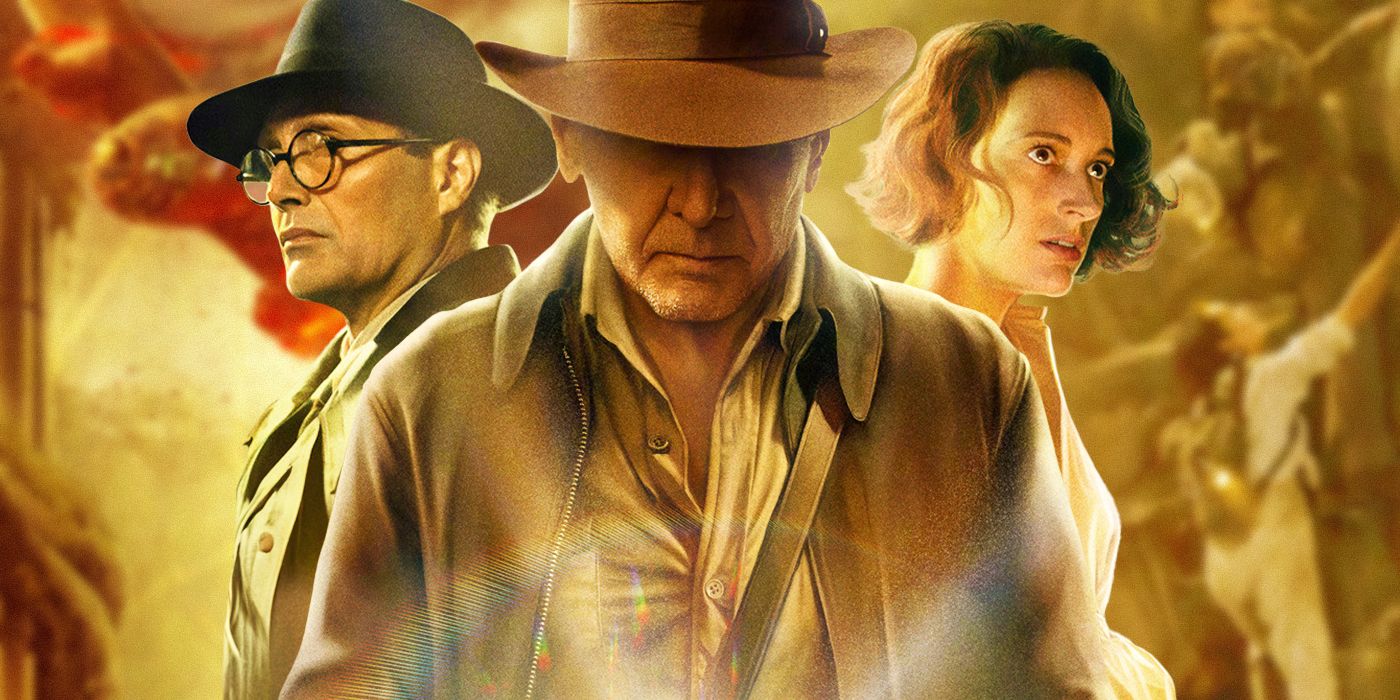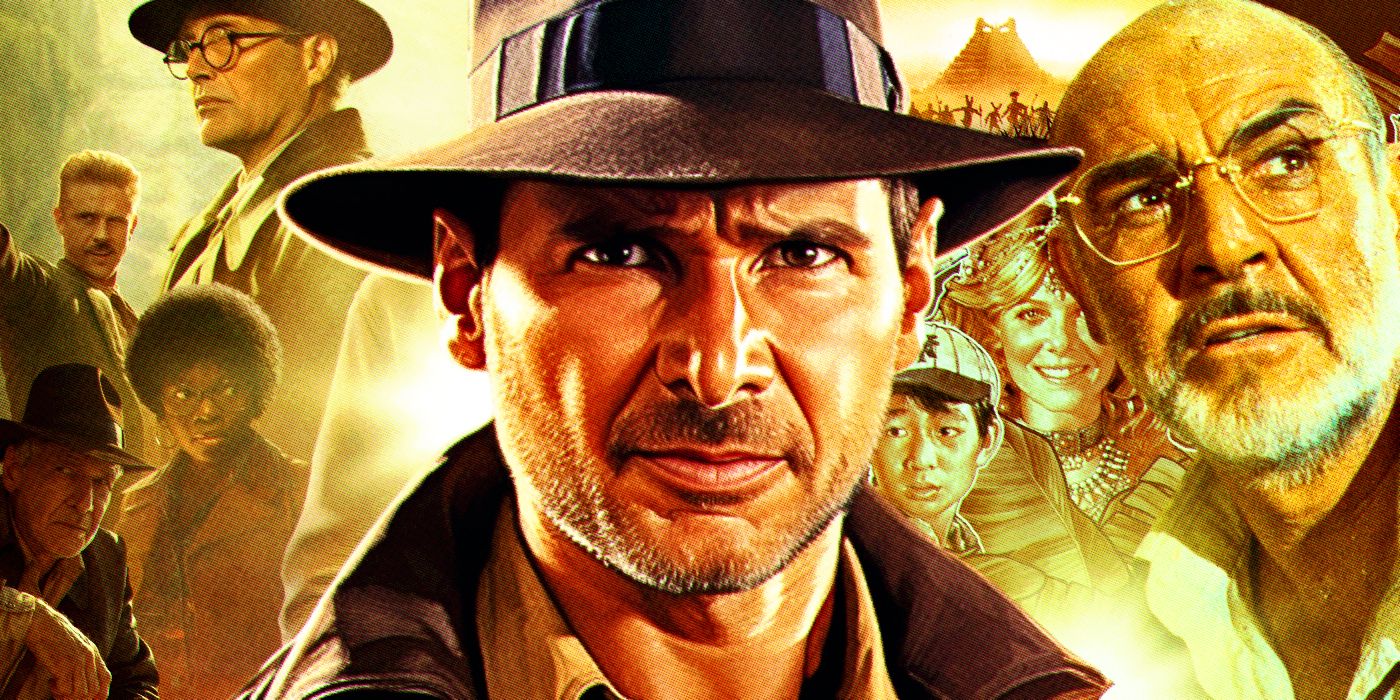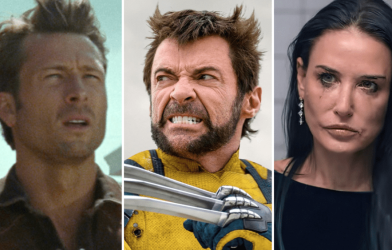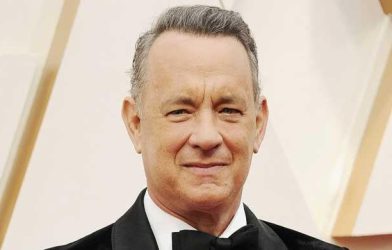The Big Picture
- Spielberg and Lucas’ collaboration began with the desire to create a James Bond film, leading to the birth of the Indiana Jones franchise.
- Each Indiana Jones film offers a fresh story and structure, with varying degrees of success in balancing adventure and character dynamics.
-
Indiana Jones and the Dial of Destiny
provides a satisfying conclusion to Indy’s story, emphasizing character growth and emotional depth over action set pieces.
The inception of the Indiana Jones franchise actually began with the desire to make a film in another, already established film series. Steven Spielberg and George Lucas were on vacation together in 1977 during the opening weekend of Star Wars when Lucas asked Spielberg — who was in post-production on Close Encounters of the Third Kind at the time — what kind of film he wanted to make next. Spielberg said he’d always wanted to direct a James Bond film, to which Lucas replied, “Well, I’ve got that beat.” The Star Wars filmmaker proceeded to pitch an adventure film in the vein of the 1930s and 40s serials starring a heroic archeologist named Indiana Smith. Spielberg loved everything but the name, suggested Jones as the new surname, and thus one of the most enduring film franchises in history was born.
The Indiana Jones franchise is also noteworthy in that no two films are too similar. Spielberg and Lucas were careful not to retread the formula of past movies, and while this resulted in a fresh story and structure each time out, not every entry was a home run, and Indiana Jones and the Dial of Destiny, directed by James Mangold (and the first installment not directed by Spielberg) continues that tradition. Below, we’ve visited all five Indiana Jones films, digging into the merits and shortcomings of each entry in this beloved, long-lasting, and ongoing franchise.
5. Indiana Jones and the Kingdom of the Crystal Skull
We begin with what is glaringly the worst of the bunch. One of the biggest problems with Indiana Jones and the Kingdom of the Crystal Skull is apparent from the opening frame, in which a distractingly-obviously-CG-created groundhog pops his head out of a mound. Indiana Jones has always been about grand adventure, using the best effects possible to put our hero in the greatest amount of danger, but a 21st-century Indiana Jones movie already begins to feel false once incongruous CG effects begin to creep in. This permeates throughout the entire film, from Shia LaBeouf swingin’ on vines with animated monkeys, to a swarm of weightless computer-generated ants carrying communist soldiers to their death. As fake as some of the bugs in Temple of Doom may have looked, they still felt tangible in relation to the actors, and tangibility goes a long way towards sweeping the audience up in the adventures of Indiana Jones.
Unfortunately, an overreliance on CG is only one of many issues plaguing the fourth Indiana Jones film. Even Cate Blanchett can’t make paranormal-obsessed villain Irina Spalko interesting, John Hurt is completely wasted as a walking, talking clue-pointer, the loyalty of Ray Winstone’s sidekick Mac doesn’t matter one bit because the character barely exists as-is, and LaBeouf performs with such emotional intensity that it feels like he’s in an entirely different film. Pretty much the only character dynamic worth anything in Crystal Skull is the one between Indy and Marion. Harrison Ford and Karen Allen easily slip back into their old rapport, giving the film a much-needed boost when it begins to get bogged down by its own convoluted plot involving saucer men from Mars.
Some took issue with the fact that Indiana Jones would be dealing with aliens in the fourth Indy film, and while another religion-focused MacGuffin may have been more suitable, it makes sense for Lucas and Spielberg to want to tackle this particular kind of story when moving the series into the 1950s. The problem isn’t aliens; it’s the specific story they choose to tell. There’s no weight to the hunt for Crystal Skulls, and as Indiana Jones starts to rattle off various off-screen adventures he’s had since we last left him, we begin longing to see those stories instead.
“Uninteresting” is the operative word of Crystal Skull, from the story to the characters to even the set pieces. The truck sequence in the jungle is the least dull of the bunch, but even then, it’s hard to care about what’s happening when we don’t really care about the characters themselves. This is a shame, because Indiana Jones is undoubtedly one of the most interesting heroes to grace the silver screen. It took years for Spielberg, Lucas, and Ford to agree on a take for the fourth Indiana Jones film, but maybe they should’ve realized the difficulty in coming up with another satisfying film meant they probably should have left well enough alone.
Indiana Jones and the Kingdom of the Crystal Skull
Indiana Jones becomes entangled in a Soviet plot to uncover the secret behind mysterious artifacts known as the Crystal Skulls.
- Release Date
- May 22, 2008
- Runtime
- 122 minutes
- Writers
- David Koepp , George Lucas , Jeff Nathanson , Philip Kaufman
4. Indiana Jones and the Temple of Doom
Spielberg and Lucas began developing Temple of Doom pretty quickly after the success of Raiders of the Lost Ark, but from the onset, they were intent on making a film that would be darker and very different from the first adventure. Lucas rooted this idea in how he approached Empire Strikes Back as the darkest entry in the Star Wars trilogy, but whereas that film simply went to some emotionally difficult places, Temple essentially becomes a horror film in its somewhat disturbing, pitch-black third act.
Things begin promisingly enough in Temple of Doom as Spielberg opens the movie with a Busby Berkeley-esque musical number followed immediately by a thrilling showdown and shootout between Indy and Lao Che (Roy Chiao). But the first hints that we may be in for a bumpy ride arrive with Kate Capshaw’s nightclub singer Willie Scott. In keeping with Spielberg and Lucas’ desire not to repeat themselves, it makes sense that they’d want to craft a wholly different female companion for Indy in the follow-up, but making Willie Scott the opposite of Marion Ravenwood means Indy shares the screen with a grating, dim, and infuriatingly self-obsessed stereotype. Again, the intention behind Willie Scott was fine, but the execution is pitched way too severely toward the damsel in distress as Willie screams and stomps like an angry toddler throughout most of the film’s runtime. While her romantic interactions with Indy are meant to evoke the tone of classic screwball comedies, more often than not they fall flat. If Raiders reflects the best of the James Bond influence, Temple embraces some of that franchise’s worst tendencies when it comes to the hero/love interest dynamic.
Indy’s other companion, Short Round, is at least endearing enough to tolerate onscreen, and the chemistry between Ford and Ke Huy Quan results in the film’s most effective comedic moments — which are absolutely vital to keeping the darkness of the movie’s second half from engulfing the movie whole. Indeed, Spielberg embraces certain aspects of the horror genre and B-movie cinema with the film’s violent finale, which certainly caught some audiences off guard. While Raiders ended in a similarly graphic fashion, it’s about balance — TempleI of Doom litters the shock value throughout the entire third act, whereas Raiders saves the gore for the money shot at the very end.
Temple of Doom isn’t a bad movie — the booby-trap sequence on the way to the temple is one of Spielberg’s most effective set pieces ever, and the mine car chase in the finale is thrilling. But the lack of a strong companion, overreliance on the wrong kind of dark tone, and lessened focus on Indiana Jones as an intellectual make it a somewhat less fulfilling entry in the franchise.
3. Indiana Jones and the Dial of Destiny
It may seem like heresy to say Dial of Destiny is better than any of the first three Indiana Jones, but the satisfying conclusion to Indy’s story, despite a blandness to the rest of the film, outweighs the shrill, irritating, and extremely questionable aspects of Temple of Doom. Dial of Destiny has some decent setpieces, like the opening flashback to a younger Ford (with some odd de-aging), and a chase through Tangier with Indy’s goddaughter Helena (Phoebe Waller-Bridge) and her sidekick Teddy (Ethann Isidore), but this might be the first Indy film where it’s the smaller moments that are better than the action scenes.
1:45

‘Indiana Jones and the Dial of Destiny’ Is More Historically Accurate Than You Think
Would you believe us if we told you the Dial of Destiny is a real thing?
Dial of Destiny treats Indy like a real person and not a cipher for whatever adventure scenario that he’s thrown into this time around. He’s a character looking at his past, discussing his previous adventures, and reckoning with the choices he’s made. As a goodbye to this iconic character, Ford is doing some great work, and it’s interesting to see Jones as a living, breathing character and not a serial star for once. It’s hard to believe, but some of the best moments of Dial of Destiny take the weaknesses of Kingdom of the Crystal Skull and makes them strengths, as Ford gives a moving explanation as to why Mutt isn’t in this film, and the film’s final moments with Indy are extremely lovely and surprisingly moving in a way this series rarely is.
To be completely honest, we probably didn’t need any Indiana Jones movies after The Last Crusade, but Dial of Destiny certainly works as a better conclusion to this series than Crystal Skull, which seems to be the primary reason why this film exists in the first place. Waller-Bridge is a charming addition to this franchise, and Mads Mikkelsen is a great villain as always — even if we’ve seen characters like him before in this universe — and they do make this feel more essential than it probably is. However, Dial of Destiny does a fairly decent job of giving Ford a goodbye to one of his most famous characters, wrapping up this series with a nostalgic, charming bow.
Indiana Jones and the Dial of Destiny
Archaeologist Indiana Jones races against time to retrieve a legendary artifact that can change the course of history.
- Release Date
- June 30, 2023
- Runtime
- 142 minutes
- Writers
- Jon Kasdan , Philip Kaufman , David Koepp , George Lucas
2. Indiana Jones and the Last Crusade
The brilliance of Indiana Jones and the Last Crusade is that it’s almost a stealth origin story. You think you’re just watching the next adventure of Indiana Jones, but in fact, the entire film is telling the audience where Indy came from and why he is the way he is. The movie literally begins with Young Indy, as Spielberg channels his love of Westerns with a thrilling sequence that runs through the foundation of some of Indy’s hallmark traits, all in the midst of an elaborate and supremely entertaining chase sequence. River Phoenix is pitch-perfect casting as the young Indiana Jones, composer John Williams gets playful with some of the best work of his career, and it all culminates with the introduction of Indy’s father, followed by an inspired cut to an adult Indy hunting the same MacGuffin decades later. And that’s just the first 15 minutes.
Last Crusade is the most ambitious film of the franchise, as Spielberg and Lucas send their hero on a globe-trotting adventure to recover yet another all-important religious artifact. But the “adventure” is, for all intents and purposes, a facade. The crux of the story lies in Indy rekindling and accepting his relationship with his father, who, in another case of spot-on casting, is played by James Bond himself, Sean Connery. The dynamic between Ford and Connery is wonderfully executed. It’s combative but never mean-spirited, and despite their estrangement, they assume dominant and submissive roles in the most subtle of ways, many times evoking the entire relationship with a simple glance.
The film also acts as Spielberg and Lucas’ rebuke to Temple of Doom. It relishes the talk-y intellectual moments of Raiders and eschews the more grotesque aspects of Temple of Doom in favor of comedy and snappy dialogue. Indeed, at times this tonal course correction goes a little overboard, losing a bit of the drama along the way (Hitler signing Indy’s Grail Diary is just silly), but overall it finds a nice balance and culminates in a wonderfully affecting finale with the highest emotional stakes of the series.
1. Raiders of the Lost Ark
Honestly, The Last Crusade makes a strong case for the best of the Indiana Jones bunch, but ultimately the consistent sharpness and God-tier-level filmmaking of Raiders of the Lost Ark nudges it just ahead to the top spot. There’s not a false note to be found in Spielberg’s buoyant, adventurous thrill ride. Karen Allen’s Marion Ravenwood is just as compelling as Indy himself, but she isn’t an attempt to create a female copy of the eponymous hero. The chemistry between the two drives the film, as does Ford’s mix of moxie, smarts, and luck that brings Indiana Jones to vivid life.
What makes Jones a unique action hero is that he’s always a little bit in over his head. He doesn’t have every beat worked out 30 steps in advance — there’s an on-the-fly quality to his attitude that makes the ride that much more enjoyable because as an audience member, you don’t necessarily feel like Indiana Jones can survive anything. He does, mind you, but it’s always a close call. The iconic image of Indy always reaching at the last moment to grab his hat is not only clever, but it’s also indicative of Indiana Jones as a whole. He makes it out in one piece, but often by the skin of his teeth.
Spielberg brilliantly sets up the world and the hero in the film’s prologue, which takes a cue from Bond by beginning the film with a set piece that’s only tangentially related to the rest of the plot. But we learn almost all we need to know about Indy in that first sequence, and then the character is even further fleshed out in the next sequence, in which this dashing hero is revealed to be a highly intelligent professor at Marshall College. What sets this apart from a “secret identity” dynamic as seen in superhero stories is that Jones’ day job and adventures are one and the same — he relishes knowledge and action, and doesn’t even necessarily need to hide one facet of his being from the other.
Looking back on Raiders of the Lost Ark now, it’s refreshing to see just how dialogue and character-driven the film is as a “blockbuster” movie. It’s an action-adventure movie, sure, but the bulk of the runtime is made up of interactions between human beings, not explosions and set pieces. And the set pieces that Spielberg does present are all the better for it, because the audience isn’t being inundated with adrenaline shot after adrenaline shot. They come at opportune moments, they’re impeccably crafted, and they’re wholly character-driven. Combine that balance with some of the most compelling characters put on screen, throw in a hefty dose of Harrison Ford’s charm and vulnerability, and you’ve got a recipe for an enduring masterpiece.
Indiana Jones and the Raiders of the Lost Ark
In 1936, archaeologist and adventurer Indiana Jones is hired by the U.S. government to find the Ark of the Covenant before the Nazis can obtain its awesome powers.
- Release Date
- June 12, 1981
- Runtime
- 115 minutes









